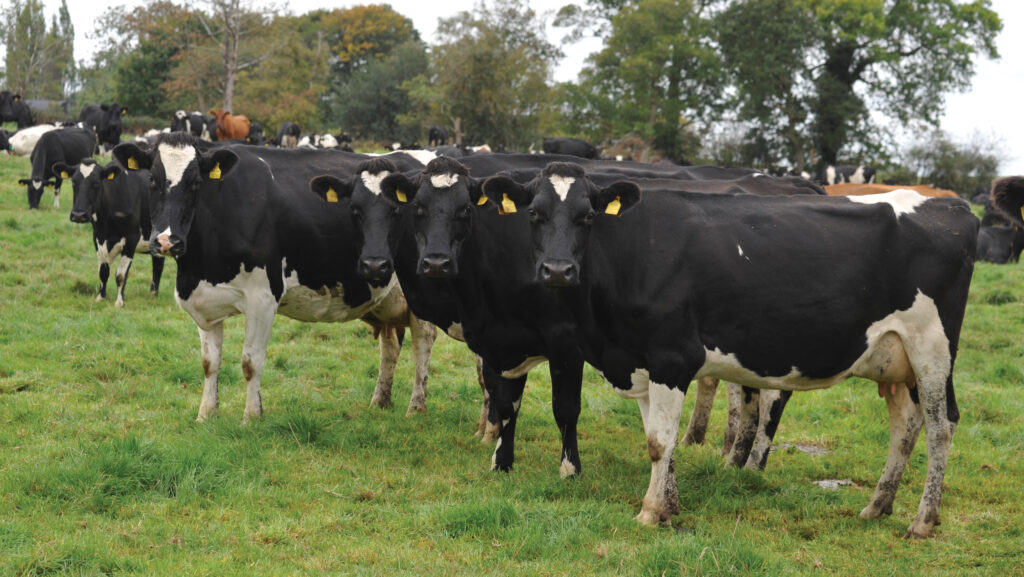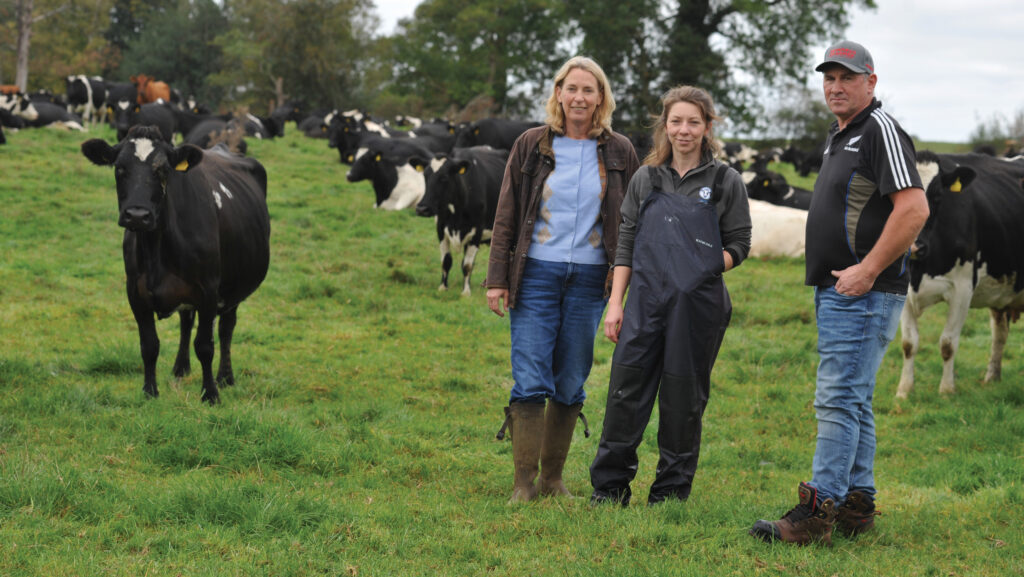How teamwork got dairy herd’s mastitis spike under control
 Cows at Lower Farm, Shropshire © Debbie James
Cows at Lower Farm, Shropshire © Debbie James When mastitis rates unexpectedly surged in Steve and Emma Furnival’s spring-calving herd, it put pressure on every part of their business — from cow health and profitability to team morale.
“Having never had a problem before, infection rates just went through the roof,” Emma says.
“We had milk quality cell count results pinging onto our phones daily, and the pressure was felt across the business, on our profit margins and on our team.”
See also: What are the most common causes of mastitis in UK herds?
Farm facts
Lower Farm, Bearstone, Shropshire

Emma Furnival (left), farm vet Jenny Bellini and herd manager Haydyn Brown © Debbie James
- 126ha of owned land farmed and 32ha rented for silage and additional grazing
- 330 Friesian milking cows
- 10-week calving block from the beginning of February
- 4,800 litres a cow a year at 4.8% fat and 3.7% protein
- Milk supplied to Arla on an Arla Care contract
- 18% herd culling rate
Two years on and that same team at Lower Farm in Bearstone, Shropshire, have turned things around.
Working closely with farm vet Jenny Bellini of the Sandstone Vet Group; Map of Ag veterinary consultant James Breen; and herd manager Haydyn Brown, the farm has improved udder health immeasurably.
In just one year, new infection rates during the dry period have dropped from 25% to 7%, cure rates now stand at 82%, and somatic cell counts (SCCs) have almost halved.
“The results have been incredible; everyone kept going under pressure and it has paid off,” says Emma.
“With the support of James and Jenny – who brought fresh pairs of eyes and holistic viewpoints – we worked out where changes were needed, focused on quick wins, and then addressed the areas where a small amount of capital could make a big difference.”
Data-led decision-making
Taking a data-driven approach was fundamental to reducing the mastitis rate.
Using the AHDB Mastitis Control Plan and Mastitis Pattern Tool, Steve and Jenny drilled down into herd data to pinpoint the source of infections.
This clearly established that the pattern was environmental, and originating in the dry period.
Jenny used herd management software to review every cow’s mastitis and SCC history.
She introduced a tighter threshold of 100,000 cells/ml when selecting cows for dry cow therapy, down from 200,000 cells/ml the previous year.
“That change might not sound dramatic, but it reflected where the herd really was at the time,” she explains.
“It made the plan realistic and achievable.” As a result, the rolling SCC average has dropped from 246,000 cells/ml to 131,000 cells/ml.
Best practice at drying off
Jenny delivered an on-farm refresher training session to align the farm team on best practice at drying off, covering everything from hygiene to handling.
“It really pulled everyone together, and we’ll definitely be repeating that training annually,” says Emma.
“In a block-calving system, getting the dry period right is everything. Get that wrong and you’re on the back foot from the start.”
Changes to housing and cow space
Jenny and James reviewed the housing, while practical, on-farm changes were led by Haydyn.
By repurposing a spare bay, stocking density in the calving shed was reduced, meeting AHDB’s recommendation of 1.25sq m for every 1,000 litres of milk produced.
Yards were opened up to provide more space for cows in the cubicle housing and to create a loafing area.
Feed space was increased to 0.75m a cow, and new stainless-steel tipping water troughs were installed to encourage higher intakes and allow for easier cleaning.
“If a cow drinks more, she’ll eat more, and that supports better body condition and immunity,” says Emma.
The farm also made changes to the cleaning regime in the calving shed. The passageways were always scraped daily, with water troughs checked and straw blown into the four bays.
Now, at times of peak use, each bay is mucked out weekly, instead of fortnightly, and sprayed with a chemical disinfectant targeting coccidial oocysts.
And during those peak calving periods, straw is blown into the bays twice a day, rather than once.
Steve says that commissioning Jenny and James to review the housing was invaluable. “Fresh eyes challenge your thinking,” he maintains.
Pregnancy testing has been increased from once to twice to give more accurate calving dates.
“It allows us to manage stocking density in each of the four sheds better,” he says.
“There are still pinch points, which are unavoidable in a block-calving herd, but the data show us when these will occur and that means they can be better managed.”
Milking and medicine protocols refined
Although the mastitis pattern was environmental and deriving from the dry period, milking protocols were also reviewed.
A hot water wash is now used for the bulk tank and plant after both morning and afternoon milkings, and this has cut Bactoscan readings to an annual average of 23,000 cells/ml.
On James’s recommendation, in-line mastitis detectors are used to help milkers identify clinical infection at an early stage.
“Early detection is everything,” Jenny says. “The longer mastitis goes unnoticed, the lower the cure rate.”
The farm has also switched to using a Category D dry cow tube. “This is a little bit broader spectrum, and as we had a bit of resistance to the previous drug used, it was a no brainer to switch,” says Jenny.
“Where needed, we upped the use of [a non-steroidal anti-inflammatory] to reduce pain and inflammation during recovery.”
Record-keeping
Steve’s detailed herd records allow precise management of calving and housing pressure points.
As well as increasing pregnancy diagnosis frequency, milk recording pre-drying off is now done at both morning and afternoon milkings.
This is providing better insights into cow’s milk yields than recording once a day.
“If a cow is producing under 15 litres a day, Jenny reviews her pregnancy status, body condition and health to take a holistic view on whether we should be drying that cow off early,” says Steve.
Before the dry period, Jenny meets with the team to review data and plan the next steps – a visit that is part-funded by the Animal Health and Welfare Pathway.
The future
With udder health now good, the herd is in a strong position, and that means cows with chronic mastitis can be selectively culled.
“This time last year, 14% of cows had high cell counts, and now it’s just 6%,” says Steve. “We can finally make strategic decisions rather than firefighting.”
Specifically, the data of each cow will be scrutinised – her condition, milk yield and cell count status throughout the lactation – to make early decisions on drying off and on which cows to cull.
For Steve and Emma, collaboration has unquestionably been key to getting on top of the mastitis issues.
“Having Jenny and James in the team has been absolutely vital. Their focus, attention to detail and willingness to question everything made the difference.
“It has shown us that small and consistent improvements really do add up,” says Emma.
